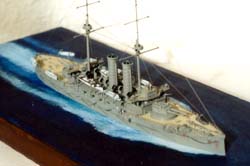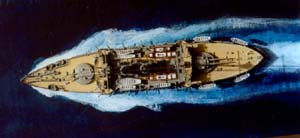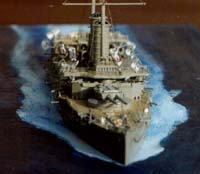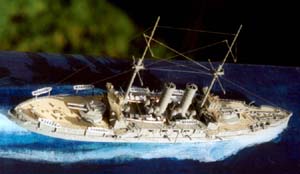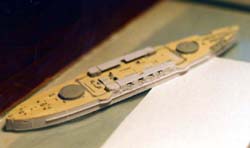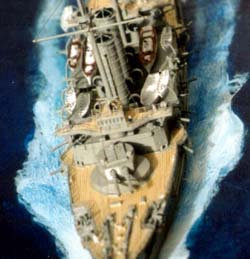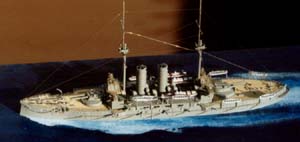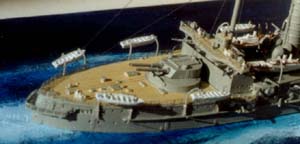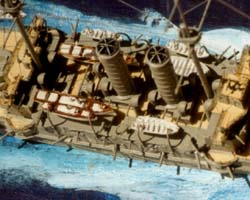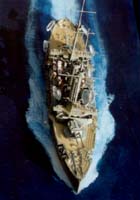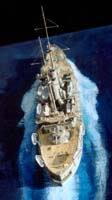HI-Mold 1/700 Resin Pre-Dreadnought Mikasa
|
|
History
Prior to World War Two, the best known ship in the Japanese navy was
the pre-dreadnought Mikasa. Laid down 24 January 1899 by Vickers in Great
Britain and completed 1 March 1902, she was the most modern ship in the
Japanese fleet when war with Russia broke out in February 1904. At the
time Mikasa was serving as the flagship of Admiral Togo and she wore his
flag at the battle of Tsushima. Following the end of hostilities she was
at anchor in Sasebo harbour when her magazine exploded on 12 September
1905 and she sank, Mikasa was refloated in August 1906 and recommissioned
in 1907. In September 1921, she was reclassified as a 1st Class Coast
Defence Ship, but that same month she ran aground near Askold Island,
later refloated and ultimately stricken in 1923. In 1926 Mikasa was opened
as a memorial in Yokosuka where she remained until 1945. Her condition
deteriorated between 1945 and 1959, but in 1960 she was restored and is
now on display as the only surviving pre-dreadnought battleship.
The Kit
Construction began by cleaning up all parts by removing mold gates and
such from the various assemblies. With this done all parts were washed
in preparation for painting and assembly. As usual I CAed an L shaped
piece of sprue to the bottom of the hull as a handhold, and also cut a
slot into the overturned bottom of the kit box to place the ship in while
working on it.
For this model I decided to not use the airbrush and handpainted the
entire thing. The first thing to be painted were the main, and bridge
decks using Humbrol 72. After that the hull and superstructure was next.
I had intended to paint her in the striking black, white and buff of Victorian
ships, but when the crunch came I backed down from the masking job and
just used Model Master Light Sea Grey instead. The inside of the gundeck
was painted white, as were the external shutters from each casement gun
emplacement. The various small details were also painted Light Sea Grey
at this time.
With basic painting out of the way, construction could begin. First
up was to glue the anti-torpedo booms along the hull. Brass wire is provided
for this, and there are locators along the waterline and also on the rail
where they connect. The waist guns were then added, and the structure
covering them was added. Next the forward and aft superstructure were
glued in place using CA. The beams across the waist to hold the ship's
boats were next, followed by the funnels. the funnels also served as convenient
handholds while moving the model around. The various vents were placed
around the funnels.
With the midships area basically complete, the decks were added to the
fore and aft superstructure. Each had a small prepainted deckhouse added
to the top. The next thing to go on were the photoetched rails. Although
Hi-Mold include a fret of PE with the kit, there aren't enough rails to
do the entire kit. I used the kit rails for the main deck and bridges,
but had to use some WEM rails around the forward casements.
The ship's boats were painted white overall with brown decks and set
aside to dry. While this was taking plaace the various davits were CAed
into place. After that the boats were CAed onto the davits or the boatdeck
as required. The main guns and smaller weapons were added, as were the
anchors and anchor davits.
The masts were built from the brass rod provided. Around now I realised
I should have drilled the holes for the masts earlier- ie before the funnels
were in place. I carefully drilled them, and then CAed the masts to the
hull. The platform on each was CAed in place, as were the upper masts.
Yards were CAed into place and very basic rigging added.
I weathered the entire model with washes of RUST-ALL, both the rust
and the darkening bottles were used.
The base
Once again I took the cheap and easy route for displaying my Mikasa.
I turned the bottom of the box the kit came in over and painted a sea
scape on it using various Ceramcoat blues and whites. The sides of the
box were cut down and painted brown. A slot was also cut into the box
to allow the hull to sit flush with a scrap of L shaped sprue affixed
to the bottom.
With the model complete, I glued the hull to the base using white glue,
and then cut off the bottom of the L-shaped piece of sprue.
The final step was to add various 1/700 PE crewmen from Tom's
Modelworks. I painted the sailors in white uniforms and the officers
in dark blue. These really add to the look of the completed model
Conclusion
This was a relatively simple build due to the lack of superstructure,
however the various davits around the boat decks were a little difficult
to get done without hazarding the paint job.
Although it is hard to determine exactly when the kit is supposed to
represent Mikasa, its ease of construction, and finished appearance lead
me to give it a highly recommended for anyone interested in warships from
the early 20th century period..
Thanks to HobbyLink Japan for the review
sample.
|









|
